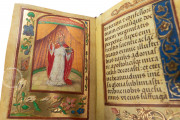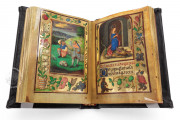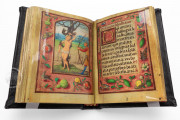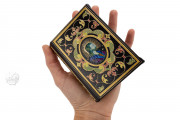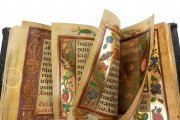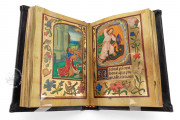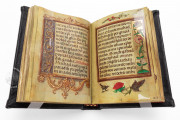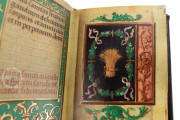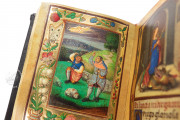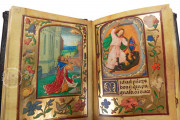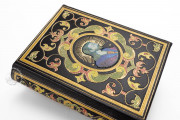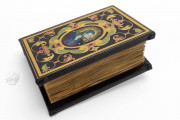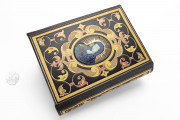The HM Prayer Book is a collection of splendidly illuminated leaves from a Christian book of hours made for a patron or patrons with the initials HM, which are given elaborate treatment in the book. The small book from which the pages derive was created around 1520-1530, perhaps in Brussels. Its illumination is the work of a follower of the Master of Charles V. The assembled leaves include fifteen full-page miniatures, eight three-quarter-page miniatures, and twelve half-page calendar illustrations depicting everyday activities through the months.
The original book's core text was the Hours of the Virgin, a series of prayer services focused on the Virgin Mary, and four of the surviving fragment's full-page miniatures originally embellished those prayer services (fols. 15v, 17v, 40v, and 50v). Eighteen of the surviving leaves are taken from the suffrages (short prayers) to saints (fols. 16, 19-20, 27, 37-38, 41, 43-49, 52-54, 56, and 58) and twelve from the calendar (fols. 1-12).
Characteristically Flemish Manuscript Art
The elaborately painted borders—many with illusionistic fleshy acanthus vines, flora, birds, and other creatures—are a characteristic feature of manuscript art of early sixteenth-century Flanders. The artist was a follower of the Master of Charles V, named for his work in the First Prayer Book of Charles V. The follower adopts the master's palette featuring muted blues, pinks, and greens, as well as his somewhat elongated figural proportions and exaggerated gestures.
Snowball Fight!
The calendar was arranged with each month occupying four pages, the first page boasting a half-page miniature of a typical activity for that month. The scenes for April and May feature aristocratic women (fols. 4r and 5r), but most of the calendar miniatures depict male laborers engaged in agricultural work. Three boys participate in December's snowball fight, with a windmill and a church in the distance (fol. 12r)
Medieval Saints
Many of the depicted saints are legendary or historical martyrs of the earliest Christian centuries. There are also three medieval saints: Saint Bernard of Clairvaux (d. 1153), the fourteenth-century Saint Roch, and Saint Elizabeth of Hungary (1207-1231) (fols. 30v, 49v, and 56v). Elizabeth both wears and holds a crown, and two heraldic shields in the lower border point to her elevated place in the ruling houses of Hungary and Thuringia.
Special Prayers
Among the devotions illustrated in the fragment are the Seven Verses of Saint Gregory, which promise the supplicant 14,000 years of indulgence. A full-page miniature of the Mass of Saint Gregory opens the text (fol. 23v). The manuscript is written in Gothic Textualis, the most formal book script of the time. The image of the golden initials H and M tied by green tasseled silk appears at the end of Lauds of the Hours of the Virgin (fol. 15r).
A Binding of Colored Inlays
Léon Gruel (1841-1923) created the black leather binding with colored inlays and two enamel plaques. The enamels, depicting Christ on the front cover and the Virgin Mary on the back, imitate the style of seventeenth-century work. Peter Marié (d. 1903) owned the manuscript in its current configuration before Henry Walters (1848-1931) acquired it sometime before it entered the collection of the Walters Art Gallery (now Walters Art Museum).
We have 1 facsimile edition of the manuscript "HM Prayer Book": Il Libro d'Ore del Maestro di Carlo V facsimile edition, published by Imago, 2023
Request Info / Price



